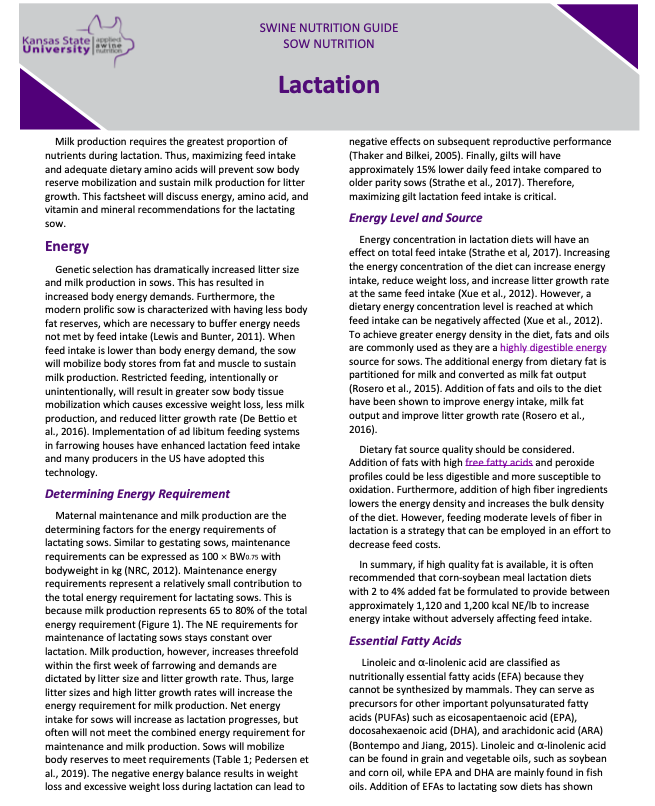Energy
Genetic selection has dramatically increased litter size and milk production in sows. This has resulted in increased body energy demands. Furthermore, the modern prolific sow is characterized with having less body fat reserves, which are necessary to buffer energy needs not met by feed intake (Lewis and Bunter, 2011). When feed intake is lower than body energy demand, the sow will mobilize body stores from fat and muscle to sustain milk production. Restricted feeding, intentionally or unintentionally, will result in greater sow body tissue mobilization which causes excessive weight loss, less milk production, and reduced litter growth rate (De Bettio et al., 2016). Implementation of ad libitum feeding systems in farrowing houses have enhanced lactation feed intake and many producers in the US have adopted this technology.
Determining Energy Requirement
Maternal maintenance and milk production are the determining factors for the energy requirements of lactating sows. Similar to gestating sows, maintenance requirements can be expressed as 100 ´ BW0.75 with bodyweight in kg (NRC, 2012). Maintenance energy requirements represent a relatively small contribution to the total energy requirement for lactating sows. This is because milk production represents 65 to 80% of the total energy requirement (Figure 1). The NE requirements for maintenance of lactating sows stays constant over lactation. Milk production, however, increases threefold within the first week of farrowing and demands are dictated by litter size and litter growth rate. Thus, large litter sizes and high litter growth rates will increase the energy requirement for milk production. Net energy intake for sows will increase as lactation progresses, but often will not meet the combined energy requirement for maintenance and milk production. Sows will mobilize body reserves to meet requirements (Table 1; Pedersen et al., 2019). The negative energy balance results in weight loss and excessive weight loss during lactation can lead to negative effects on subsequent reproductive performance (Thaker and Bilkei, 2005). Finally, gilts will have approximately 15% lower daily feed intake compared to older parity sows (Strathe et al., 2017). Therefore, maximizing gilt lactation feed intake is critical.
Energy Level and Source
Energy concentration in lactation diets will have an effect on total feed intake (Strathe et al, 2017). Increasing the energy concentration of the diet can increase energy intake, reduce weight loss, and increase litter growth rate at the same feed intake (Xue et al., 2012). However, a dietary energy concentration level is reached at which feed intake can be negatively affected (Xue et al., 2012). To achieve greater energy density in the diet, fats and oils are commonly used as they are a highly digestible energy source for sows. The additional energy from dietary fat is partitioned for milk and converted as milk fat output (Rosero et al., 2015). Addition of fats and oils to the diet have been shown to improve energy intake, milk fat output and improve litter growth rate (Rosero et al., 2016).
Dietary fat source quality should be considered. Addition of fats with high free fatty acids and peroxide profiles could be less digestible and more susceptible to oxidation. Furthermore, addition of high fiber ingredients lowers the energy density and increases the bulk density of the diet. However, feeding moderate levels of fiber in lactation is a strategy that can be employed in an effort to decrease feed costs.
In summary, if high quality fat is available, it is often recommended that corn-soybean meal lactation diets with 2 to 4% added fat be formulated to provide between approximately 1,120 and 1,200 kcal NE/lb to increase energy intake without adversely affecting feed intake.
Essential Fatty Acids
Linoleic and α-linolenic acid are classified as nutritionally essential fatty acids (EFA) because they cannot be synthesized by mammals. They can serve as precursors for other important polyunsaturated fatty acids (PUFAs) such as eicosapentaenoic acid (EPA), docosahexaenoic acid (DHA), and arachidonic acid (ARA) (Bontempo and Jiang, 2015). Linoleic and α-linolenic acid can be found in grain and vegetable oils, such as soybean and corn oil, while EPA and DHA are mainly found in fish oils. Addition of EFAs to lactating sow diets has shown improvements in litter performance and subsequent sow reproductive performance and played a role in stimulating an immune response in piglets (Farmer et al. 2010; Rosero et al., 2016). Therefore, the amount of essential fatty acids in the diet is important as sows will secrete EFAs in the milk. Research is still limited on the minimal total EFA provided from ingredients that improves lactation and subsequent reproductive performance. Rosero et al. (2016) recommends that sows consume 125 g/d of linoleic and 10 g/d of linolenic fat during lactation. Ingredients containing high levels of these EFAs (flax seed oil, corn oil, soybean oil and menhaden oil) can substantially increase diet costs. Therefore, nutritionists need to balance the cost of meeting minimal EFA levels with the potential benefits in reproductive performance.
